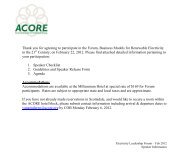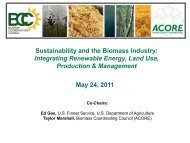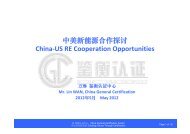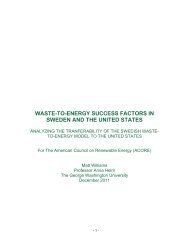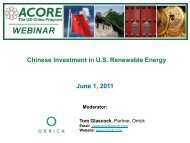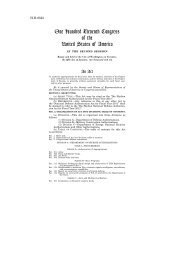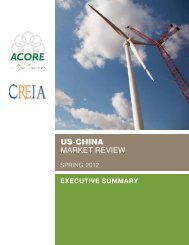Read More - American Council On Renewable Energy
Read More - American Council On Renewable Energy
Read More - American Council On Renewable Energy
You also want an ePaper? Increase the reach of your titles
YUMPU automatically turns print PDFs into web optimized ePapers that Google loves.
Currently, planning is geographically fragmented andlocally focused. Siting multi-state transmission facilities isa long and contentious process involving numerous statesand local agencies each with the power to block an entireproject. Further, cost allocation of transmission investmentsmakes it difficult to finance a coherent interstatetransmission network for renewables.The answer is a national clean energy smart grid designedto build new interstate transmission capacity to bringrenewable energy from remote areas to population centersthat demand it. Smart grid technologies will managepower flows, improve reliability, facilitate end-use efficiency,and assist with the integration of clean distributedresources.The future of the industry relies on theconvergence of distributed renewable energyresources and a smart grid.A national clean energy smart grid will expand renewableelectricity, enhance reliability of the electricity system andstrengthen our economy by creating jobs and opportunitiesfor business. This upgraded transmission grid willallow utility companies and consumers to monitor andadjust their electricity use, while providing a pricingsystem to integrate new renewable energy sources andenergy storage devices.Distributed energy will provide greater stability to theelectricity grid by helping meet baseload power, peakingpower, backup power, remote power, power quality, as wellas cooling and heating needs. It will also allow customersto feed any excess power they produce back to the grid forother consumers to use.<strong>Energy</strong> storage technologies will be one of themost transformative technologies for theelectricity industry.The grid needs a consistent, stable supply of energy thatcan be adjusted during times of peak demand. Newenergy storage options can help provide such a supply andare essential for stabilizing the grid, ensuring a continuityof supply, increasing energy autonomy, mediating againstintermittent power production and expanding renewableenergy sources.Grid improvements could help move renewableenergy to the Southeast—the fastest growingregion in the nation.The Southeast will have a significant need for new generationin the future due to rapid population growth. This willbe a great opportunity for renewable energy growth.However, because there is a limited amount of renewableresources actually located in the region, the success ofrenewable energy development in the Southeast dependson grid improvements and the increased capacity to movethe renewable energy resources.With competitive pricing for baseloadrenewables utilities will have to considerthese generation sources to meet theirsupply needs.– D’Juan Hernandez, President & CEO, Sun <strong>Energy</strong> GroupThere are overlooked benefits of placingdistributed energy projects on industrial orbrownfield real estate.Currently, the trend is to place green projects on greenland, with the assumption that agricultural land is aneasier option, though far from the grid. But, the land isnot properly zoned, is environmentally sensitive andextensive environmental reviews are required.Further, building new transmission lines from the middleof the country to cities takes roughly 10 years, whereasdistributed generation on previously zoned industrial landtakes between 1 to 9 years. Using land use law to ouradvantage will get projects built on sites where municipalitiescannot say no. Industrial zoned lands are zoned toinclude electric generation, have minimal environmentalreview and are often in non-environment sensitive areas.<strong>On</strong>e example is the Buffalo Steel Wind Project inLackawanna, New York – just outside of a city wherepower is needed and close to the grid.<strong>Energy</strong> Security and US Competitivenessin the Global MarketInvestments in renewable energy can decreaseAmerica’s oil dependence and improve nationalsecurity.The US imports roughly 13 barrels of oil eachday – over 60% of its total daily consumption.This dependence on imported oil ties theUS economy to unstable and often undemocraticnations. We can decrease thisdependence on foreign sources of energy by<strong>American</strong> <strong>Council</strong> <strong>On</strong> <strong>Renewable</strong> <strong>Energy</strong>Executive Summary Report 59






